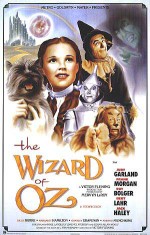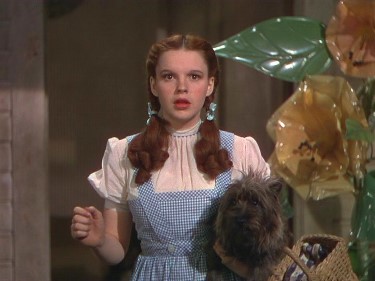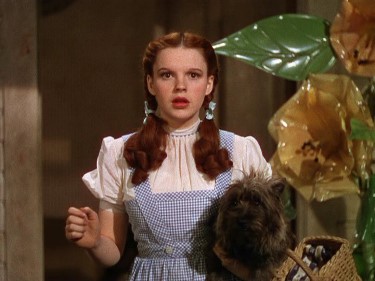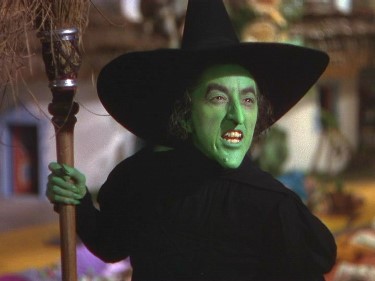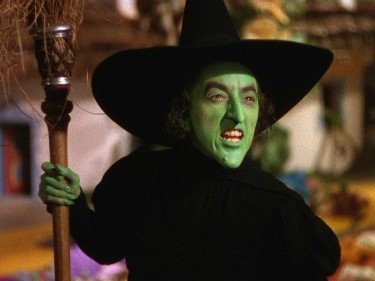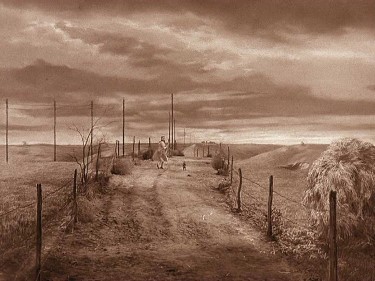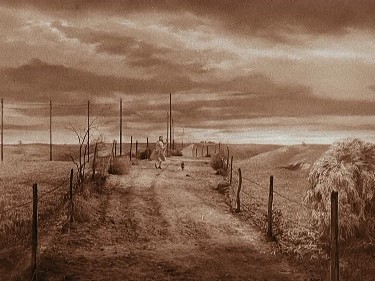 |
||||||||||||||
|
For any reader who has just become acquainted with American culture and hasn’t been indoctrinated with this particular piece of apple pie, I summarize the plot of The Wizard of Oz. The details are drawn from the children’s book published in 1900 by L. Frank Baum; changes in the 1939 film are discussed below. Dorothy Gale, a young girl living on a poor farm with her Aunt Em and Uncle Henry in rural Kansas, is swept away by a cyclone (properly described as a tornado) with her tiny dog Toto--in her house no less--to the fairy-tale land of Oz, which is presided over by witches--both good and bad, talking animals, flying monkeys, and similar characters. During her arrival, the house lands on, and pulverizes, the Wicked Witch of the East, oppressor of Munchkinland--Munchkins being small, colorful beings. Hailed as their heroine, she receives the magic silver shoes (“ruby slippers” in the film, see below) that were formerly the property of the deceased witch. Wishing to go home, she is counseled by the Good Witch of the North that she should follow the yellow brick road to the Emerald City where she must ask the mysterious Wizard of Oz for help. Along the journey, she meets a living Scarecrow in need of a brain, a Tin Woodman in need of a heart, and a talking Lion in need of courage; they join forces and proceed to the Emerald City. When the Wizard agrees to help them on the condition that they kill the Wicked Witch of the West--even nastier than her deceased east-coast counterpart, they warily comply and, almost getting killed themselves in the process, succeed. The Wizard turns out to be a fraud who placates the Oz characters with odd trinkets but is unable to help Dorothy return home. It turns out that, as Glinda, the Good Witch of the South informs her, the enchanted silver shoes have the power to transport her back to Kansas. The End.
For a Hollywood enterprise of that era, the film stays remarkably close to the first book in Baum’s series of fifteen (one of them a book of short stories; other writers provided further entries over time), although many details, characters, and subplots are omitted or telescoped, with a few new elements added. The trip to Oz is now Dorothy’s fever-dream after a blow to the head from a window that flies off its hinges during the cyclone. It is part of a framing story that was filmed in black & white and tinted sepia for release--a deliberate contrast with the Technicolor Oz; in the added Kansas framework, most of the Oz characters are given analogous counterparts: Miss Gulch/the Witch, three farmhands/Dorothy’s companions, Professor Marvel/the Wizard. Also added is a revenge subplot in which the Western Witch stalks Dorothy for causing the death of her sister (there’s no evidence that they are actual “sisters” in the book) and for taking the magic footwear--which change from the book’s “silver” to “ruby” because red was more impressive in Technicolor; they are also called “slippers” in the film rather than “shoes,” though they are clearly red-sequined pumps. The Wizard’s payment for helping the needy quartet is softened from “killing” the Wicked Witch of the West to “bringing him her broomstick,” which, as the Tin Woodman observes, amounts to the same thing. The Good Witch of the North is a kindly old lady in the book who appears only at Dorothy’s arrival in Munchkinland; in the film she is conflated with the young and attractive Glinda, Good Witch of the South. The melding of the two good witches presents a real dilemma when it is the same character who reappears near the end and casually tells Dorothy that she “always had the power to return to Kansas,” after she and her cohorts were nearly liquidated by the Western Witch in their attempt to satisfy the terms of the phony Wizard’s bargain; the film’s “Glinda, the Good Witch of the North” adds the weak excuse that Dorothy wouldn’t have believed her earlier. Glinda, therefore, just seems manipulative and irresponsible at that point--in a way, as cruel as the more forthright wicked witches. It sorely taxes one’s suspension of disbelief that Dorothy and her beleaguered friends don’t assault her bodily at that moment. Moreover, the hackneyed “no place like home” cliché that Glinda presents is completely at odds with Dorothy’s real need to escape from an unpleasant existence in search of something better. As author Salman Rushdie pointed out in his monograph on Oz, the desire expressed so plaintively in “Over the Rainbow” is far more compelling and wholly outweighs the desire to return to a thankless and oppressive “home”--a contradictory, stale truism doubtless added in one of the film’s many rewrites (there were fourteen writers who worked on the picture at one time or another, as well as five directors: it was a troubled project). It also negates Baum’s belief that creativity and travel expand mind and spirit: Dorothy returns to Oz throughout his series of books, eventually even bringing Aunt Em and Uncle Henry with her. It was not intended to be a fever-dream. The Wizard of Oz is a monument to Hollywood’s idealization of the American myth; and thanks to strategically positioned CBS television broadcasts beginning in 1956 that became a tradition in the 1960s, it is indelibly etched in the psyches of most baby boomers. The legendary Judy Garland plays the role of Dorothy with complete conviction but also infuses it with a palpable wistfulness, pathos, insight, and size that are a little unbelievable for a child--not to mention one wearing Technicolor lipstick, the customary use of adolescents to play children notwithstanding. Moreover, unlike Garland’s troubled Dorothy, the book’s heroine is unaccountably cheerful, a contrast with her weary, unsmiling aunt and uncle whose hard lives of poverty on a subsistence farm have made them old prematurely. I find the most energetic and natural performances to be Bert Lahr’s priceless vaudevillian Lion, Margaret Hamilton’s iconic Witch, and Clara Blandick’s high-strung, overworked, yet compassionate Aunt Em, who rings true as a farmer’s wife trying to survive during the Great Depression, though the farm, complete with hired hands, is luxurious compared with the one described in the book. Margaret Hamilton is not given credit for her third role: the Wicked Witch of the East into whom the framing story’s disagreeable Miss Gulch metamorphoses outside the sepia-tinted window of the airborne house--not into the Western Witch as most people assume: you can see those ruby shoes sparkling on her feet as she rides her broom. The Wicked Witch of the West--“WWW” as Miss Hamilton was fond of signing her autographs--only gets wind of sis’ untimely demise ten minutes later and arrives in Munchkinland wearing black shoes. It makes sense: a witch traveling so close to a flying house would logically be the one who ends up under it. Of course, this skews the framing story a bit when it’s the admittedly identical-looking WWW (maybe the sisters were twins) with whom Dorothy must contend in Oz rather than Miss Gulch’s actual Oz counterpart, dispatched early on. It does, however, give WWW the revenge motivation that allows us to see a lot more of Margaret Hamilton’s delicious performance (WWW has a very small role in Baum’s story)--even though some lines were deleted after the preview (she was too scary for the kids in the audience, including a member of Baum’s family), making a few elements in her speeches and actions puzzling. Both the 1999 transfer in the one-disc “Special Edition” (UPC 012569512320)--now discontinued but not difficult to find on eBay or from third-party Amazon.com sellers--as well as the 2005 transfer that appears in a two-disc “Special Edition” (UPC 012569675360) and three-disc “Collector’s Edition” (UPC 012569677050) are restorations from the best surviving film elements: the camera negatives preserved in the George Eastman House. Using cutting-edge digital technology, the three Technicolor strips were aligned for optimal focus, and the ravages of time were reversed with great care--twice. Decisions about color, contrast, and framing differ between the transfers even though many of the same people worked on both.
Warner's 1999 transfer is the first actual restoration, with an immaculate, nearly damage-free appearance; the color can seem a bit subdued at times, partly owing to a relatively high brightness level which, however, yields very transparent detail: e.g., the folds of the Witch’s cloak and the hair that protrudes from beneath her hat, Toto’s eyes and strands of fur, are all wonderfully crisp. Dorothy’s rosy cheeks have a fresh, girlish quality; the copper-based makeup of the Witch’s green face is an accurate, specific shade; and the grass in the Scarecrow’s field is a completely appropriate color. Warner used its somewhat controversial “Ultra-Resolution” process for the 2005 DVD, and certainly the visual results are more opulent, the color close to saturation; the picture has deeper black levels and a great deal of contrast. It is exciting though its seductive splendor can be misleading. The most discernible details are those benefiting from the darker, heavily contrasted picture: in the bonus feature “Prettier than Ever,” the restoration engineers are at pains to point out the more visible weave in the burlap of the Scarecrow’s head (at 1:30:10). Yet, transparency has been sacrificed in brighter scenes. The same details cited as examples in the 1999 DVD are less natural in the 2005 transfer: its darkness obscures the folds of the Witch’s cloak and hair; Toto’s eyes and fur are blurred. The intense color occasionally gives Dorothy’s rosy cheeks the impression of too liberally applied rouge; the Witch’s green makeup is sometimes almost lime-colored; the grass in the Scarecrow’s field is too dark. Details in the 1999 DVD seem clearer because the brighter image and paler color reveal more information. However, the transfer engineers in 2005 may have been attempting to reproduce the somewhat unrealistically strong primary colors peculiar to the original three-strip Technicolor process. The type of equipment used to produce this look was discontinued in the mid 1970s. A noteworthy late film to use it was Dario Argento’s 1977 Suspiria; by then, Argento and his cinematographer Luciano Tovoli could only find a single three-strip Technicolor camera to borrow in Rome--after which it was itself dismantled. For Suspiria--in some respects Oz’s evil twin, also about a girl far from home who inadvertently runs afoul of witches--Argento required the surreal, garish primary colors only available with the old three-strip process. Although the 2005 transfer of Oz is too dark and contrasted at times, the abundant color may accurately represent the original process. The unrestored out-of-print 1998 MGM DVD (UPC 027616604491) has the same vibrant colors and dark appearance, for that matter.
Warner claimed that film shrinkage of the color strips at unequal rates over time caused size distortion in the 1999 restoration, asserting that in 2005, it was computer-corrected for perfect alignment. While the brightness and more muted colors do make the 1999 picture seem “soft” at times, there are other instances where it is noticeably sharper than the 2005 image, in which the contrast, augmented black levels, and extreme color cause some blurring. Warner was obviously pitching their “double-dip”; after all, they were proud of the earlier DVD until 2005, never mentioning any difficulty with the transfer. The sepia-tinted black & white opening and closing scenes (directed by the uncredited King Vidor)--the only sections for which original negatives do not survive--have noticeable grain and flicker in the 2005 edition, but not in the 1999 version. The sepia tinting is too orange in both. The restorers really needed to look no further than the film itself for the proper shade: when Aunt Em is seen in the Witch’s crystal ball, we are immediately shown the pale brown sepia intended for Kansas. It is dreary and unappetizing, demonstrating with its actual tone and texture, the aridity and isolation of the terrain and Dorothy’s life; it would also have provided the greatest possible contrast with the Technicolor Oz, had the transfer colorists heeded the obvious clue. The sepia tones used in the Warner DVDs are quaint rather than drab and depressing. The most apt sepia choice I have encountered appears in the unrestored 1989 MGM/UA 50th Anniversary VHS. In addition, compared with Warner, the sepia in the 1998 MGM pre-restoration DVD had a diminished orange cast in Kansas, and a more orange sepia crystal-ball Aunt Em, so they matched. On the other hand, only one video version has ever convincingly coordinated the Kansas sepia with the sepia-painted, Technicolor-photographed transition shot before Dorothy opens the door on Oz. The 1999 DVD makes the door, wall, Dorothy’s gingham dress and elbow look like sepia-tinted black & white; all other versions, including the 2005 restoration, render an obviously sepia-painted door and wall, a brown-colored gingham dress, and, most pointedly, the clearly flesh-colored elbow of Judy Garland’s stand-in Bobbie Koshay. The 1999 transfer is the only one that truly impresses with an astounding contrast as Dorothy reveals Oz. “Stencil printing”--each frame tinted sepia by hand at that point--in addition to the Technicolor-shot sepia door, wall, and dress--was the process used to create the effect in 1939; it was revived for the 1999 DVD transfer. It must have made the original audiences gasp, as I did when I saw the 1999 edition after viewing this film throughout a lifetime. It is unfortunate that the process was not reused in 2005.
The remixed 5.1 soundtrack was culled from authentic elements. According to an article about the sound restoration for a 1998 Warner theatrical re-release HERE, “the process started with...the mono optical release composite, a mono Music & Effects (M & E) track and two music ‘angles.’ The angles were protection tracks, optically recorded to allow for later versatility in mixing. Though the original nitrate elements were lost, the angles had been transferred wild to 15 ips ¼” [tape] for archiving sometime in the 1960s.” Clearly, although it is organically conceived, avoiding external enhancements, the 5.1 mix is not specific to the 2005 transfer. More importantly, the original monophonic soundtrack is included as a separate option in the 2005 DVD, accessed through the “Special Features” menu; it was inexplicably absent from the 1999 transfer despite its listing on the box. On ordinary stereo TV monitors, the mono sounds clearer. Yet I would caution that even the mono track in the 2005 version is not entirely original. In creating the new sound track for that 1998 theatrical reissue, the same article cited above indicates that some small “corrections” to actual content were made. Although they were intended only for the specific purpose, they clearly found a permanent home on the 1999 and 2005 DVDs: e.g., Dorothy now only whimpers “Oh Toto” rather than “Oh Toto, Toto” when the dog is placed in Miss Gulch’s basket (at 9:49 in the 2005 edition). Perplexingly, the 1998 engineers heard the line as “Oh To, oh Toto” instead of “Oh Toto, Toto” and believed it to be a bad edit, so they deleted the first two syllables--and they have never been restored (nor do I believe they will be). Another fragment of our cultural history is thus chipped away as a gaffe replaces a fact. To hear the unedited original sound track, one must seek out-of-print pre-Warner DVD and VHS versions. Another important observation: TV overscanning crops images by 5% or more on all sides. If overscanning can be overcome by adjusting the TV or DVD player (older Toshiba players had a “shrink” feature for the purpose), then one would see the entire original image. Such is the case with the 1999 edition. But in the 2005 “Ultra-Resolution” transfer, Warner has zoomed the image slightly, making everything in the frame minimally larger; the result is that, unlike the 1999 transfer, the edges are cropped even without overscanning. Many companies remaster old films with this zooming/cropping procedure, perhaps because they think buyers subliminally prefer larger images on the screen when widescreen is not an option, or possibly because spreading the image over a few more scan lines/pixels increases the resolution. Most people would never notice the difference and it’s not worth losing edge information, certainly not in historically significant films. Typically, opening and closing titles are reduced in size to the original frame dimensions so no text is lost. It is all unnecessary and more than a little questionable ethically. At least the film remains in its correct 1.37:1 aspect ratio with nothing reframed (unlike the extreme distortions perpetrated upon early talkies with their squarer aspect ratios). The image in the pre-restoration 1998 MGM DVD is likewise slightly zoomed and cropped. The third disc of the “Collector’s Edition” contains the silent Oz films and a 28-minute Baum biography. Except for the restored 72-minute racist 1925 film, which is far removed from Baum, the silents are in very poor condition. Ted Eshbaugh’s 1933 Oz cartoon--the first time we see a black & white Kansas and color Oz--is inventive, but the last 40% are unrelated to Oz. The substance of the Baum bio is covered elsewhere in the set. Nothing on the disc contains chapter divisions, the only access via cumbersome scanning. Included are “collectibles”: an in-house newspaper, reproductions of programs and lobby photos; these double the price over the two-disc “Special Edition.” Most important extras in the two-disc set are ported over from the 1999 single-disc (oddly, Angela Lansbury reads what were originally introductory text frames): [1] Deleted scenes and fragments. (Note: the 2005 audio for the “Jitterbug” number is the completed extant track with orchestra while the 1999 DVD substitutes a rehearsal with piano.) [2] Trailers. [3] “Jukebox”: several hours of audio clips from recording sessions. [4] A cloying 1990 documentary narrated by Angela Lansbury with some good interview material. [5] Bits from the animated 1967 ABC-TV series “Off to See the Wizard.” [6] Special effects footage about the cyclone. [7] Photo galleries. The 1999 edition includes some extras not in the 2005 two-disc version: [1] Clips from the silent films and 1933 Oz cartoon (more than enough). [2] Bits from interviews with Margaret Hamilton, Ray Bolger, and Jack Haley in PBS’s 1979 “The Wizardry of Oz.” New to the 2005 two-disc set: [1] Actor bios with clips of their other work, minus Judy Garland’s complex bio. The plain-text bios on the 1999 disc are more informative. [2] A 2001 TCM documentary. [3] Angela Lansbury reading excerpts from the first Baum Oz book. [4] A history of the film’s rise to mythic status owing to annual CBS airings. [5] “Prettier than Ever”: the restorers discuss the “Ultra-Resolution” process which was rather new to them. [6] Various film-makers’ and actors’ ruminations on Oz. [7] Informative commentary track by historian John Fricke inter-cutting interview excerpts, some from the 1999 disc, that reportedly replace additional material that Fricke provided. The 2005 edition lists the film’s running time as 103 minutes while the 1999 DVD lists 101. The film runs between 101:36 and 101:41 in all NTSC versions: the correct 102-minute length is cited on the old MGM DVD. The two Warner restorations are so different in concept that there is no clear “winner.” The 2005 “Ultra-Resolution” Oz has vivid Technicolor, an excellent commentary track, the mono sound track (valuable despite 1998 edits), and some new extras. The 1999 transfer has an unzoomed image, often clearer detail, a brilliantly convincing transition from black & white to color, and most of the same extras on its single disc; it also seems less “gimmicky.” The three-disc “Collector’s Edition” is for Oz completists. --Robert E. Seletsky ©2006 |
||||||||||||||
|
